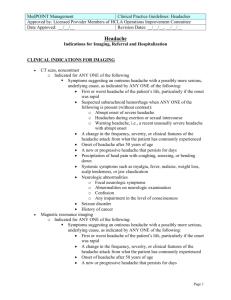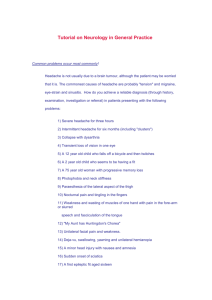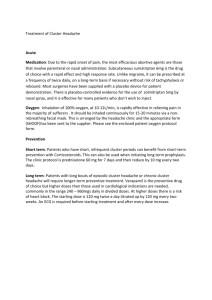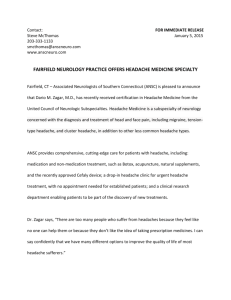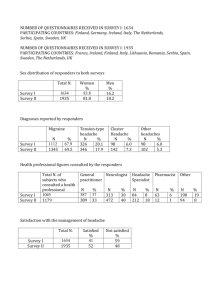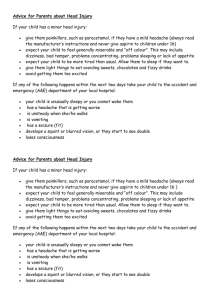Headache - Health Care LA
advertisement
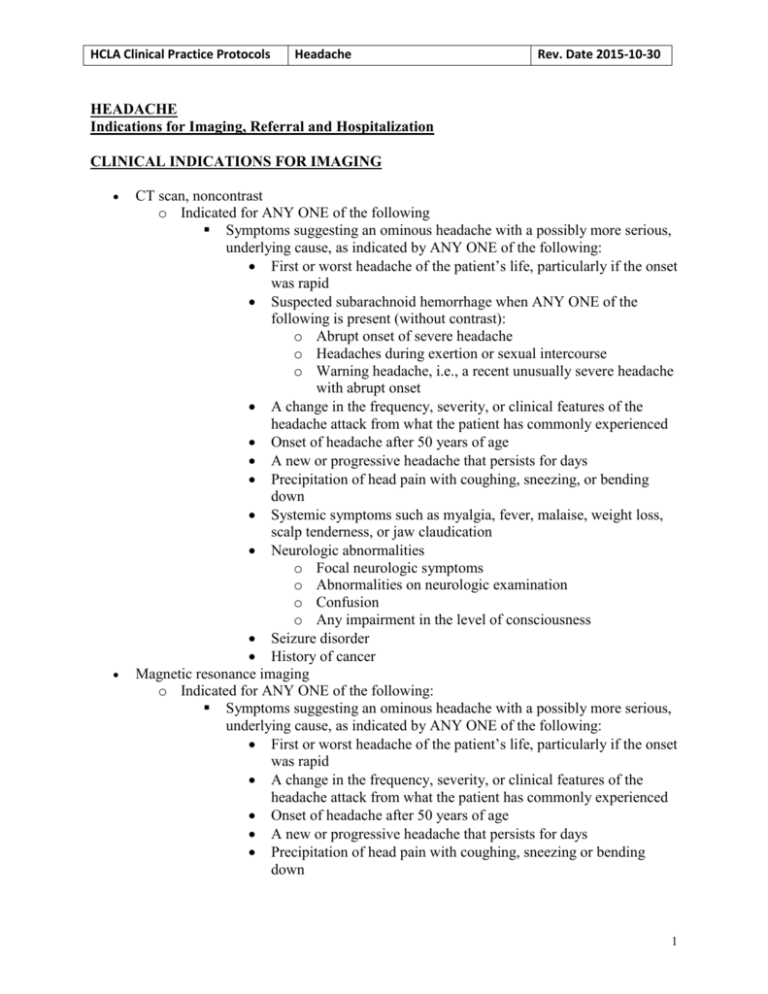
HCLA Clinical Practice Protocols Headache Rev. Date 2015-10-30 HEADACHE Indications for Imaging, Referral and Hospitalization CLINICAL INDICATIONS FOR IMAGING CT scan, noncontrast o Indicated for ANY ONE of the following Symptoms suggesting an ominous headache with a possibly more serious, underlying cause, as indicated by ANY ONE of the following: First or worst headache of the patient’s life, particularly if the onset was rapid Suspected subarachnoid hemorrhage when ANY ONE of the following is present (without contrast): o Abrupt onset of severe headache o Headaches during exertion or sexual intercourse o Warning headache, i.e., a recent unusually severe headache with abrupt onset A change in the frequency, severity, or clinical features of the headache attack from what the patient has commonly experienced Onset of headache after 50 years of age A new or progressive headache that persists for days Precipitation of head pain with coughing, sneezing, or bending down Systemic symptoms such as myalgia, fever, malaise, weight loss, scalp tenderness, or jaw claudication Neurologic abnormalities o Focal neurologic symptoms o Abnormalities on neurologic examination o Confusion o Any impairment in the level of consciousness Seizure disorder History of cancer Magnetic resonance imaging o Indicated for ANY ONE of the following: Symptoms suggesting an ominous headache with a possibly more serious, underlying cause, as indicated by ANY ONE of the following: First or worst headache of the patient’s life, particularly if the onset was rapid A change in the frequency, severity, or clinical features of the headache attack from what the patient has commonly experienced Onset of headache after 50 years of age A new or progressive headache that persists for days Precipitation of head pain with coughing, sneezing or bending down 1 HCLA Clinical Practice Protocols Headache Rev. Date 2015-10-30 Systemic symptoms such as myalgia, fever, malaise, weight loss, scalp tenderness, or jaw claudication ANY ONE of the following neurologic abnormalities: o Focal neurologic symptoms o Abnormalities on neurologic examination o Confusion o Any impairment in the level of consciousness Seizure disorder Constitutional symptoms: fever, weight loss, or cough History of cancer HIV positive patient, generally as preferred test (NOTE that neuroimaging is usually not warranted in patients with migraine and normal neurologic examination). CLINICAL INDICATIONS FOR REFERRAL Refer to neurologist for ANY ONE of the following: o Diagnosis is unclear o Unsatisfactory response to treatment o Focal neurologic findings or altered mental status o Change in headache pattern o Sudden onset of severe headache, with no previous history of headaches o Abnormal findings on CT scan or magnetic resonance imaging, if done CLINICAL INDICATIONS FOR HOSPITALIZATION Admission may be indicated for ANY ONE of the following: o Suspected organic causes or findings requiring hospitalization for diagnosis and therapeutic intervention, including ANY ONE of the following: Subarachnoid or intracranial hemorrhage Unruptured but threatening vascular malformation Venous sinus thrombosis Stroke Increased intracranial pressure Encephalitis, meningitis, or brain abscess Toxic or metabolic decompensation Head trauma Malignant hypertension Acute neurologic signs Significant and persistent mental status change o Severe headache, including rebound headache, with intractable nausea and vomiting unresponsive to outpatient interventions Reference: 2 HCLA Clinical Practice Protocols Headache Rev. Date 2015-10-30 Milliman Care Guidelines, “Ambulatory Care”, 8th Edition. 3

